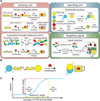Monitoring of post-translational modification dynamics with genetically encoded fluorescent reporters
- PMID: 23576192
- PMCID: PMC3883948
- DOI: 10.1002/bip.22254
Monitoring of post-translational modification dynamics with genetically encoded fluorescent reporters
Abstract
Post-translational modifications (PTMs) of proteins are essential mechanisms for virtually all dynamic processes within cellular signaling networks. Genetically encoded reporters based on fluorescent proteins (FPs) are powerful tools for spatiotemporal visualization of cellular parameters. Consequently, commonly used modular biosensor designs have been adapted to generate several protein-based indicators for monitoring various PTMs or the activity of corresponding enzymes in living cells, providing new biological insights into dynamics and regulatory functions of individual PTMs. In this review, we describe the application of general design strategies focusing on PTMs and discuss important considerations for engineering feasible indicators depending on the purpose. Moreover, we present developments and enhancements of PTM biosensors from selected studies and give an outlook on future perspectives of this versatile approach.
Keywords: FRET; biosensor; microscopy.
Copyright © 2013 Wiley Periodicals, Inc.
Figures

Similar articles
-
Fluorescent biosensors of intracellular targets from genetically encoded reporters to modular polypeptide probes.Cell Biochem Biophys. 2010;56(1):19-37. doi: 10.1007/s12013-009-9070-7. Cell Biochem Biophys. 2010. PMID: 19921468 Review.
-
Fluorescent biosensors for real-time tracking of post-translational modification dynamics.Curr Opin Chem Biol. 2009 Oct;13(4):392-7. doi: 10.1016/j.cbpa.2009.07.009. Epub 2009 Aug 12. Curr Opin Chem Biol. 2009. PMID: 19682946 Free PMC article. Review.
-
New Strategies for Probing the Biological Functions of Protein Post-translational Modifications in Mammalian Cells with Genetic Code Expansion.Acc Chem Res. 2023 Oct 17;56(20):2827-2837. doi: 10.1021/acs.accounts.3c00460. Epub 2023 Oct 4. Acc Chem Res. 2023. PMID: 37793174
-
Protein Engineering for Spatiotemporally Resolved Cellular Monitoring.Annu Rev Anal Chem (Palo Alto Calif). 2025 May;18(1):217-240. doi: 10.1146/annurev-anchem-070124-035857. Epub 2025 Feb 25. Annu Rev Anal Chem (Palo Alto Calif). 2025. PMID: 39999860 Review.
-
Genetically encoded fluorescent biosensors illuminate kinase signaling in cancer.J Biol Chem. 2019 Oct 4;294(40):14814-14822. doi: 10.1074/jbc.REV119.006177. Epub 2019 Aug 21. J Biol Chem. 2019. PMID: 31434714 Free PMC article. Review.
Cited by
-
Role of Post-translational Modifications in Influenza A Virus Life Cycle and Host Innate Immune Response.Front Microbiol. 2020 Sep 4;11:517461. doi: 10.3389/fmicb.2020.517461. eCollection 2020. Front Microbiol. 2020. PMID: 33013775 Free PMC article. Review.
-
A GFP-based ratiometric sensor for cellular methionine oxidation.Talanta. 2022 Jun 1;243:123332. doi: 10.1016/j.talanta.2022.123332. Epub 2022 Mar 3. Talanta. 2022. PMID: 35276500 Free PMC article.
-
Metabolic labeling in middle-down proteomics allows for investigation of the dynamics of the histone code.Epigenetics Chromatin. 2017 Jul 6;10(1):34. doi: 10.1186/s13072-017-0139-z. Epigenetics Chromatin. 2017. PMID: 28683815 Free PMC article.
-
Fluorogenic Photoaffinity Labeling of Proteins in Living Cells.Bioconjug Chem. 2019 May 15;30(5):1309-1313. doi: 10.1021/acs.bioconjchem.9b00203. Epub 2019 Apr 17. Bioconjug Chem. 2019. PMID: 30978287 Free PMC article.
-
Time-tagged ticker tapes for intracellular recordings.Nat Biotechnol. 2023 May;41(5):631-639. doi: 10.1038/s41587-022-01524-7. Epub 2023 Jan 2. Nat Biotechnol. 2023. PMID: 36593408 Free PMC article.
References
Publication types
MeSH terms
Substances
Grants and funding
LinkOut - more resources
Full Text Sources
Other Literature Sources
Miscellaneous

